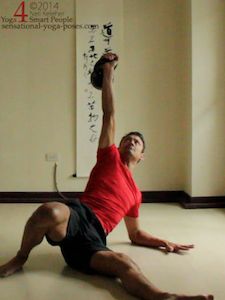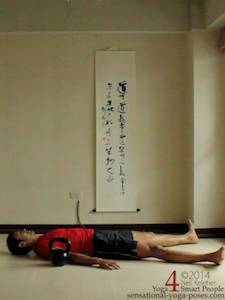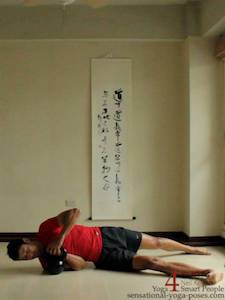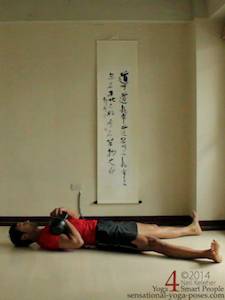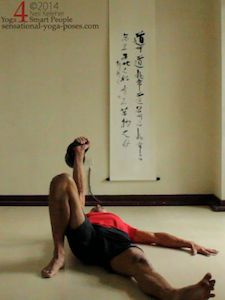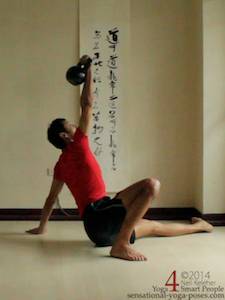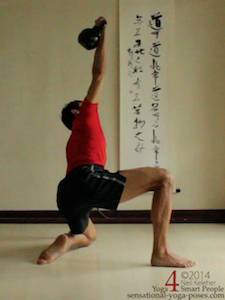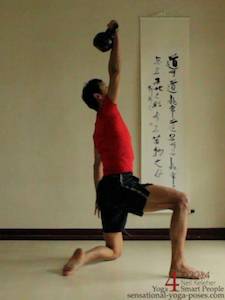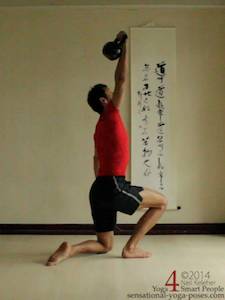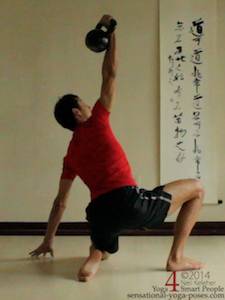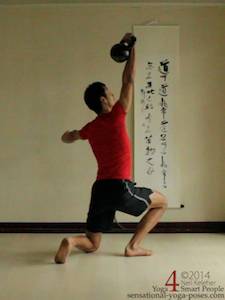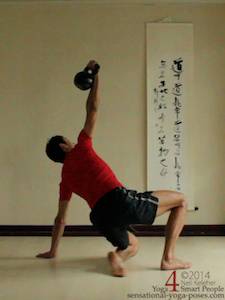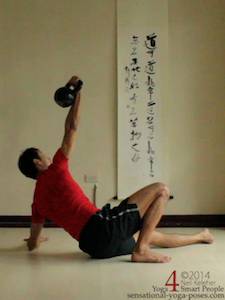At all times during the Get Up, keep your wrist as straight as possible.
Rather than letting the weight of the kettlebell bend your wrist backwards make a concerted effort to keep your wrist at least reasonably straight.
You may have to "adjust" the bend so that the kettlebell hangs comfortably against your forearm.
Racking the Kettlebell
The first step in the Get Up is to rack the kettlebell. By this, I mean get it in a position so that you can press it upwards, away from your body.
Even if doing the exercise without weight, go through the motions.
Get close to the weight.
- If lifting with your right arm lay down so that the kettlebell is beside your right shoulder. Roll on to your right side and snuggle up to the kettlebell.
- Place your hand through the handle so that the base of your hand (near where it connects to the wrist) is underneath the handle. Grab the handle.
- Place your left hand over your right hand so that you are hugging the kettlebell with both hands.
- Roll on to your back bringing the kettlebell with you. It should end up hanging over your right upper arm.
Pressing the Arm Upwards
With practice you can roll and then press the kettlebell vertically upwards in one smooth motion. Failing that you can squeeze your arm (engage your rotator cuff) and press the bell up while keeping your arms, forearms and shoulder all engaged.
You can also use both hands together to get the kettlebell up so that your right arm is vertical and your elbow straight.
At this point you could try lowering the kettlebell, with control, then once the weight is down, roll onto your right side to lower it to the floor.
Especially with heavier weights you may want to avoid the extreme external rotation of simply dropping the kettlebell beside you. More to the point, whichever way you lower the kettlebell, do it with awareness, notice if you are putting your elbow or shoulder under undue stress. If this is the case, then change the way you lower the kettlebell.
Also, when both pressing the bell and lowering it, keep shoulders and arm muscles engaged. Squeeze your entire arm.
The Turkish Get Up 2 Rolling
Because you are holding the kettlebell (imaginary or otherwise) with your right hand, bend your right knee and place your foot flat on the floor.
I'd suggest having your foot close to your buttock (right buttock) and even slightly outside of it.
You can use your right foot to help lift the right side of your pelvis and roll on to your left side.
When you roll, you use your leg to lift the right side of your pelvis. However because of the kettlebell, you are going to have to use your abs so that your ribcage turns as well. The feeling is like a very clumsily punch upwards. You use your whole body to turn and punch your right arm upwards.
You have to combine this action with getting up onto your left elbow.
Propping Yourself Up and Positioning Your Lazy Leg
Two things you can play with while rolling during the Turkish get up (and even if you think you get it while doing this without weight, experiment again when doing it with weight,) adjust the position of your left arm (the arm that is on the floor).
Either move it outwards more or perhaps even inwards, towards your body.
Find a position where you feel like you could roll up onto your elbow easily.
You can also vary the position of your left foot. Just for the experience you can try "rolling" with your left leg out wide to the left. You can also experiment with having your left leg closer to your right foot or then even behind your left foot.
See if, when rolling on to your left side you can keep your left leg on the floor.
I find that without weight, if I reach my left leg to the left, almost at 90 degrees to my body (but still on the floor) it feels easier to keep it down.
Allowing Your leg to Move with Your Pelvis
During the Turkish get up, when you are rolling your pelvis to the side notice your right foot and knee. I allow my right knee to move left so that my leg goes with the roll.
The idea is that the leg moves with the pelvis so that it can continue to push.
Anyway, as you are pushing up, allow your knee to move inwards.
Using Your Elbow or Your Abs
Doing the Turkish Get Up with weight (as opposed to without a kettlebell) I found that instead of using my elbow to prop myself up with, I was actually using my abs and curling upwards. This is more the case with weight than without it. Without weight I try to push my elbow into the floor. The feeling is similar to "elbowing" somebody, not that I've done that.
Try getting up on to your elbow and then lowering down from here with control. Again do this both without weight and with it. You may also find that once you are up on your elbow it is easy to then get up onto your hand.
If you do get up onto your hand use your shoulder to press your ribcage up away from the floor. Lengthen your neck at the same time and continue to look up.
When lowering, especially with weight, keep looking up as if you are trying to go up but slowly allow yourself to be pulled down.
The Turkish Get Up, Getting Your Knee Beneath You
Once you can get up on to your hand (and from there back to the ground) the next task is to lift your pelvis so that you can get your right knee under the kettlebell and under your body.
So that this is easier, use your right leg to push your pelvis up. If you like you can push your pelvis up as high as possible just so that you can say that you can do it. The most important thing though is getting your pelvis high enough that you can easily position your left knee under your body and under the weight. You can then rest your body weight on that knee.
Then "stand" up on that knee (and your other foot) taking your left hand off of the floor.
From here, practice looking up while slowly reaching down with your free hand (the left hand) see if you can gently touch the floor and then position your palm to take the weight.
A side note, to get your knee under the weight when going up, you have to bring your left foot slightly behind your right, hence lifting your hips slightly higher if you need to. When going back down, once your weight is on your hand remember to replace your left leg to the outside of your left foot.
Standing Up, The Final Element of The Turkish Get Up
To stand up, move your right foot closer to your left knee, slowly shift your weight to your right foot (feel when all of your weight is on your right foot) then straighten up using your right foot to stand. Get your left foot on to the ground so that you can then have your weight on both feet.
Continue looking up.
If you like, during this standing process, you can reach your left hand (the free one) out to the side in a way that feels balanced.
Getting Down from the Turkish Get Up
To get back down, because the kettlebell is in your right hand, shift your weight to your right foot then slowly bend your left knee and touch it to the floor.
As with touching your hand to the floor, see if you can do this with control.
Go up and down a few times and get used to "touching" your knee to the floor.
Next, reach your hand down and touch it to the floor behind you.
This step may be easier if you practiced it while "standing up."
Once your hand is on the floor you can use the shoulder to help support your upper body and the weight of the kettlebell. Use your right leg (the standing leg) to take the weight of your hips so that you can then move your left leg forwards.
Repeat on the other side.
Analyze Your Turkish Get Up
Because the Turkish Get Up is an asymmetrical exercise, you may notice differences between sides, especially when using weight.
For myself I found that my left arm was noticeably weaker when pressing the kettlebell up from the rack position.
So I try to remedy this by focusing on how I squeeze my arm muscles when doing the left side.
This same arm is week when I do yoga poses like flying splits. The nice thing about the Turkish get up is that I can practice parts that are weak and rehabilitate myself.
Corrective Yoga Exercises
For developing shoulder awareness for the upper arm read about stabilizing the shoulder blades. You may also find the side plank article helpful.
Also, because this kettlebell exercise requires body awareness you may find the page of yoga balance poses helpful also.
Published: 2012 07 09
